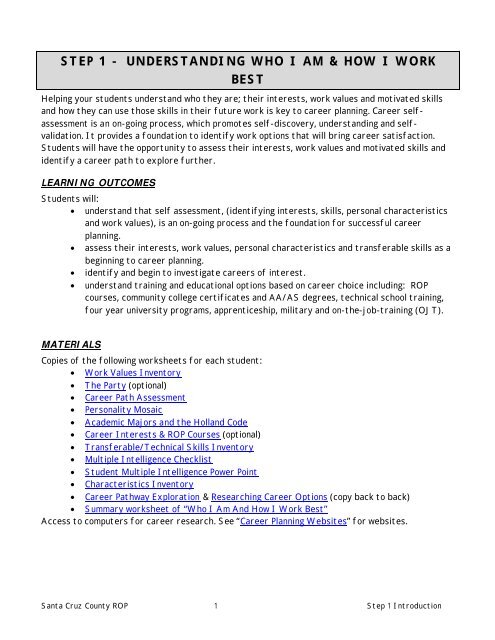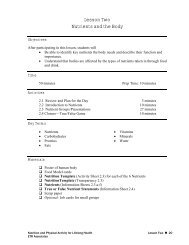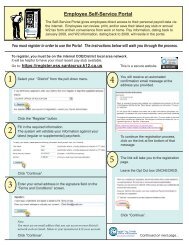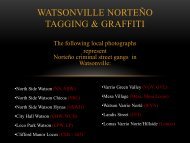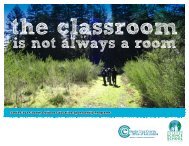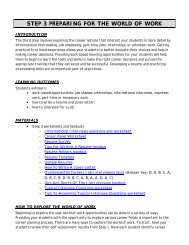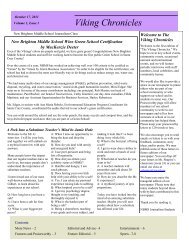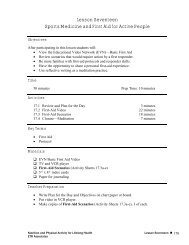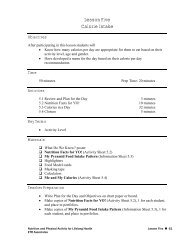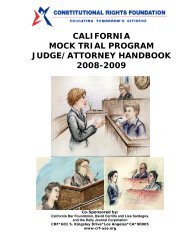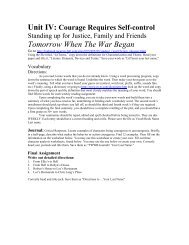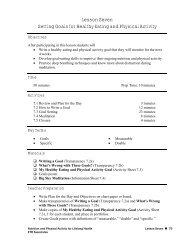Step 1 - Santa Cruz County Regional Occupational Program
Step 1 - Santa Cruz County Regional Occupational Program
Step 1 - Santa Cruz County Regional Occupational Program
- No tags were found...
You also want an ePaper? Increase the reach of your titles
YUMPU automatically turns print PDFs into web optimized ePapers that Google loves.
STEP 1 - UNDERSTANDING WHO I AM & HOW I WORKBESTHelping your students understand who they are; their interests, work values and motivated skillsand how they can use those skills in their future work is key to career planning. Career selfassessmentis an on-going process, which promotes self-discovery, understanding and selfvalidation.It provides a foundation to identify work options that will bring career satisfaction.Students will have the opportunity to assess their interests, work values and motivated skills andidentify a career path to explore further.LEARNING OUTCOMESStudents will:• understand that self assessment, (identifying interests, skills, personal characteristicsand work values), is an on-going process and the foundation for successful careerplanning.• assess their interests, work values, personal characteristics and transferable skills as abeginning to career planning.• identify and begin to investigate careers of interest.• understand training and educational options based on career choice including: ROPcourses, community college certificates and AA/AS degrees, technical school training,four year university programs, apprenticeship, military and on-the-job-training (OJT).MATERIALSCopies of the following worksheets for each student:• Work Values Inventory• The Party (optional)• Career Path Assessment• Personality Mosaic• Academic Majors and the Holland Code• Career Interests & ROP Courses (optional)• Transferable/Technical Skills Inventory• Multiple Intelligence Checklist• Student Multiple Intelligence Power Point• Characteristics Inventory• Career Pathway Exploration & Researching Career Options (copy back to back)• Summary worksheet of “Who I Am And How I Work Best”Access to computers for career research. See “Career Planning Websites” for websites.<strong>Santa</strong> <strong>Cruz</strong> <strong>County</strong> ROP 1 <strong>Step</strong> 1 Introduction
INTRODUCTION TO WORK VALUES INVENTORYIntroduce Values – Values are the core principles that give meaning to your life. When your valuesare aligned with your work activities and surroundings, you will be more satisfied. Ask and discuss:• “What is very important to you and gives meaning to your life?” (family, friends, money,honesty, trust)• Now think about your future and imagine yourself working in a career that you reallyenjoy. “What is important to you in your work?” (challenging work, money, teamwork,open communication)Hand out the Work Values Inventory. Explain that the values are divided into four areas:• Core Values• Work Environments• Work Interactions with co-workers• Work ActivitiesRank each value to its importance – Always Important, Sort Of Important or Not Important.When completed, have students go back and identify their top five values from the “AlwaysImportant” column, ranking them in order of importance. For homework, have students completethe “My Values Work Story”.INTRODUCTION TO CAREER INTERESTSInterests play an important role in the kind of work you naturally enjoy. Have your studentsimagine if they had a few hours to do anything they wanted, what would they do? Have studentsget in pairs and discuss. Ask for volunteers to share their interests. Core interests tend to remainthe same. Interests play a key role in career satisfaction and are instrumental in determiningfuture work.The Party Game – Based on the work of John Holland, a career theorist. The Party is a fun way tointroduce interests to your students. Post in your classroom the following letters – R, I, A, S, E,C, or use The Party worksheet. Describe each area as follows:Realistic (Adventuring/Producing) – Interested in athletics, good with their hands, prefer to workwith objects, machines, plants or animals rather than people. Prefer to do the job without a lot oftalk or argument, do it right the first time, get to the point.Investigative (Analytic) – Like to observe, learn, evaluate, or solve problems. This type isassociated with scientific/academic pursuits. Prefer to analyze a problem, evaluate options anddata, set a plan of action, and analyze the results.Artistic (Creative) – Interested in artistic expression. Like to work in unstructured situationsusing imagination and creativity. Prefer creative approach to problem-solving and planning whichrelies heavily on intuition and imagination.<strong>Santa</strong> <strong>Cruz</strong> <strong>County</strong> ROP 2 <strong>Step</strong> 1 Introduction
Social (Helping) – Like to work with people in some helping capacity — informing, teaching,developing, curing people. Prefer to gather data from all involved parties before generating anaction plan. Will try to find solutions equitable for all concerned. Adept at networking with people.Enterprising (Influencing) – Like to work with people in a leadership capacity — managing,performing, persuading, influencing, often for organizational or political goals or economic gain.Prefer to investigate a direct plan of action to be carried out by others. Focus on achieving thegoal, not concerned with minor details. Like to keep big picture in mind.Conventional (Organizing) – Like to work with data, numbers, more than people. Like detail, tangibleproducts, and have little tolerance for ambiguity. Like following others; instructions rather thanbeing in charge. Prefer to follow a defined structured plan of action. Attentive to detail. Enjoyputting all the pieces of a plan together.Tell the students the following: Imagine you are at a party with six different groups of people1. Imagine yourself joining the group of people that you would most enjoy being with. Go to thatcorner of the room. Talk to those in your group about what attracted you to that corner.2. Now imagine that time has passed and everyone in your group has moved on to another partyacross town except you. Of the other five groups that remain which corner would be you nexthighest area of interest? Go to that corner of the room. Talk to those in your group about whatattracted you to that corner.3. Now imagine that this group also leaves for another party. Of the other four corners remainingwhich group would you go to? Go to that corner of the room. Talk to those in your group aboutwhat attracted you to that corner.INSTRUCTIONS FOR THE CAREER PATH ASSESSMENT1. Have each student complete the Career Path Assessment to find out which career pathwaythey have the highest interest in. Do the results on the CPA also match their choice on TheParty exercise?2. Handout the Career Path Assessment.3. Have students read each statement. Circle the number of the statement that best fits theirinterests when thinking of their future.4. To score the Assessment – Pass out the answer sheet. Have students fill in the top information.Then go back to the assessment and put an “X” on the answer sheet for the correspondingnumber that is circled. Be sure to move across the paper.5. At the end, add up the number of “X’s” in each column. Put the total for each column at thebottom of the column.INSTRUCTIONS FOR THE PERSONALITY MOSAICThe Personality Mosaic helps students identify their career interests in relation to the Hollandcode. Use the same instructions as the Career Path Assessment. After completing the PersonalityMosaic have students review the worksheets – Academic Majors and the Holland Code and CareerInterests & ROP courses.<strong>Santa</strong> <strong>Cruz</strong> <strong>County</strong> ROP 3 <strong>Step</strong> 1 Introduction
INTRODUCTION TO TRANSFERABLE/MOTIVATED SKILLSHelping students identify their transferable or motivated skills, those skills they really enjoy andare good at using, is an important piece to career satisfaction. The “joy” from using the skillscomes deep from within not from the praise of others. You tend to use motivated skills even if thejob doesn’t call for them.Explain – Skills are aptitudes, or abilities, that you’ve put into practice. There are two types ofskills. “Transferable or motivated” skills are general abilities that can be used in almost everyindustry and in a wide variety of jobs. The ability to problem solve, the ability to think in spatialterms, and the ability to get your point across to others—in writing or in person—are examples oftransferable skills. “Technical” skills are more specialized and generally relate to a specific subjectmatter (medicine, climatology, cosmetology) or to a specific knowledge, such as understanding theproperties of metals or knowing which plants thrive best in certain soils.To help students identify their transferable/motivated and technical skills, have them completethe skills worksheet. After they are done ask them to talk and write about how they would like touse those skills in their career.INTRODUCTION TO MULTIPLE INTELLIGENCEIntroduce Multiple Intelligence to your students by using the power point presentation “StudentMulti. IQ” on the ROP website. Have students complete the Multiple Intelligences Checklist. Aftercompleting the checklist put students into groups based on their top multiple intelligence area fora small group discussion talking about similarities.INTRODUCTION TO CHARATERISTICS INVENTORYDiscuss positive characteristics with students. Have students complete the “CharacteristicsInventory”. Put students into triads to discuss their positive characteristics and the ones theyneed to develop.INTRODUCTION TO CAREER PATHWAY EXPLORATION1. Discuss that the next step in career planning is to find out more information about careers thatare of interest and to see how they fit with their assessment results.2. Review the Career Pathway Exploration worksheet and have students circle careers that soundinteresting to them and that they would like to explore further. Make sure the students realizethat there are many more careers than listed on the sheet. If they know of others they areinterested in, write them down and identify the pathway in which they think it would go.SUMMARY OF WHO I AM AND HOW I WORK BESTHave students review the self assessments and complete their self-assessment summary sheetbased on the assessment results. Make sure they keep this summary sheet because it will be usedlater in the career planning process.<strong>Santa</strong> <strong>Cruz</strong> <strong>County</strong> ROP 4 <strong>Step</strong> 1 Introduction


